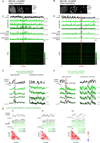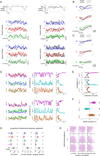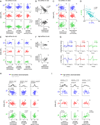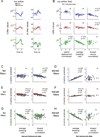Context-dependent representations of movement in Drosophila dopaminergic reinforcement pathways
- PMID: 34697455
- PMCID: PMC8556349
- DOI: 10.1038/s41593-021-00929-y
Context-dependent representations of movement in Drosophila dopaminergic reinforcement pathways
Abstract
Dopamine plays a central role in motivating and modifying behavior, serving to invigorate current behavioral performance and guide future actions through learning. Here we examine how this single neuromodulator can contribute to such diverse forms of behavioral modulation. By recording from the dopaminergic reinforcement pathways of the Drosophila mushroom body during active odor navigation, we reveal how their ongoing motor-associated activity relates to goal-directed behavior. We found that dopaminergic neurons correlate with different behavioral variables depending on the specific navigational strategy of an animal, such that the activity of these neurons preferentially reflects the actions most relevant to odor pursuit. Furthermore, we show that these motor correlates are translated to ongoing dopamine release, and acutely perturbing dopaminergic signaling alters the strength of odor tracking. Context-dependent representations of movement and reinforcement cues are thus multiplexed within the mushroom body dopaminergic pathways, enabling them to coordinately influence both ongoing and future behavior.
© 2021. The Author(s), under exclusive licence to Springer Nature America, Inc.
Conflict of interest statement
Competing Interests Statement
The authors declare no competing interests.
Figures


















Similar articles
-
Dopaminergic modulation of cAMP drives nonlinear plasticity across the Drosophila mushroom body lobes.Curr Biol. 2014 Apr 14;24(8):822-31. doi: 10.1016/j.cub.2014.03.021. Epub 2014 Mar 27. Curr Biol. 2014. PMID: 24684937 Free PMC article.
-
Distinct Dopamine Receptor Pathways Underlie the Temporal Sensitivity of Associative Learning.Cell. 2019 Jun 27;178(1):60-75.e19. doi: 10.1016/j.cell.2019.05.040. Epub 2019 Jun 20. Cell. 2019. PMID: 31230716 Free PMC article.
-
A Neural Circuit Arbitrates between Persistence and Withdrawal in Hungry Drosophila.Neuron. 2019 Nov 6;104(3):544-558.e6. doi: 10.1016/j.neuron.2019.07.028. Epub 2019 Aug 27. Neuron. 2019. PMID: 31471123 Free PMC article.
-
Drosophila memory: dopamine signals punishment?Curr Biol. 2005 Nov 22;15(22):R932-4. doi: 10.1016/j.cub.2005.10.058. Curr Biol. 2005. PMID: 16303554 Review.
-
Dopamine reveals neural circuit mechanisms of fly memory.Trends Neurosci. 2010 Oct;33(10):457-64. doi: 10.1016/j.tins.2010.07.001. Epub 2010 Aug 10. Trends Neurosci. 2010. PMID: 20701984 Free PMC article. Review.
Cited by
-
Overlapping representations of food and social stimuli in VTA dopamine neurons.bioRxiv [Preprint]. 2023 May 17:2023.05.17.541104. doi: 10.1101/2023.05.17.541104. bioRxiv. 2023. Update in: Neuron. 2023 Nov 15;111(22):3541-3553.e8. doi: 10.1016/j.neuron.2023.08.003. PMID: 37293057 Free PMC article. Updated. Preprint.
-
Inferring neural dynamics of memory during naturalistic social communication.bioRxiv [Preprint]. 2024 Jan 27:2024.01.26.577404. doi: 10.1101/2024.01.26.577404. bioRxiv. 2024. PMID: 38328156 Free PMC article. Preprint.
-
Orai-mediated calcium entry determines activity of central dopaminergic neurons by regulation of gene expression.Elife. 2024 Jan 30;12:RP88808. doi: 10.7554/eLife.88808. Elife. 2024. PMID: 38289659 Free PMC article.
-
Skewing information flow through pre- and postsynaptic plasticity in the mushroom bodies of Drosophila.Learn Mem. 2024 Jun 14;31(5):a053919. doi: 10.1101/lm.053919.124. Print 2024 May. Learn Mem. 2024. PMID: 38876487 Free PMC article. Review.
-
Neural Sequences Underlying Directed Turning in C. elegans.bioRxiv [Preprint]. 2024 Aug 11:2024.08.11.607076. doi: 10.1101/2024.08.11.607076. bioRxiv. 2024. PMID: 39149398 Free PMC article. Preprint.
References
-
- Bargmann CI & Marder E From the connectome to brain function. Nat. Methods 10, 483–490 (2013). - PubMed
-
- Schultz W, Dayan P, & Montague PR A neural substrate of prediction and reward. Science 275, 1593–1599 (1997). - PubMed
-
- Da Silva JA, Tecuapetla F, Paixão V & Costa RM Dopamine neuron activity before action initiation gates and invigorates future movements. Nature 554, 244–248 (2018). - PubMed
Publication types
MeSH terms
Substances
Grants and funding
LinkOut - more resources
Full Text Sources
Molecular Biology Databases

